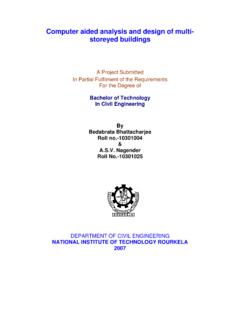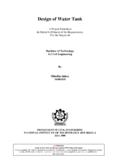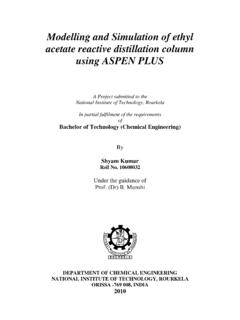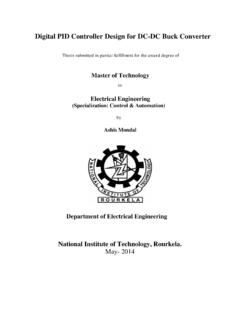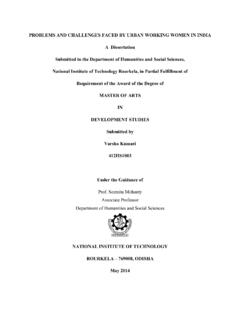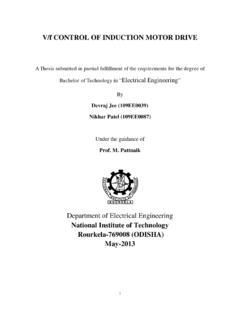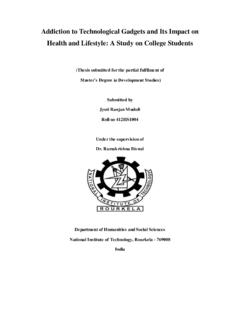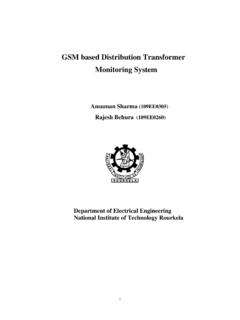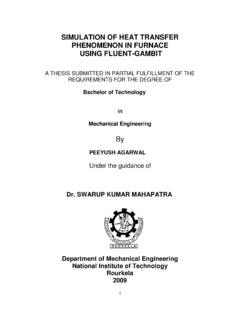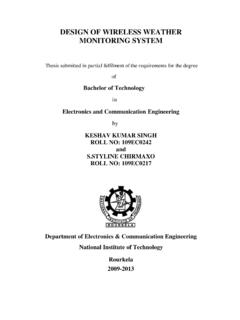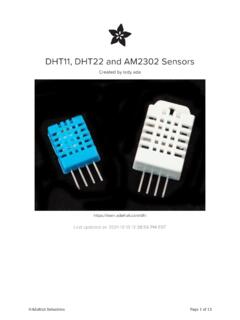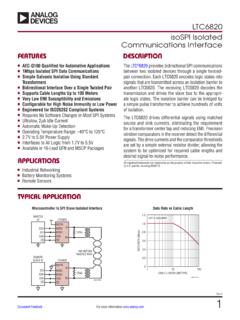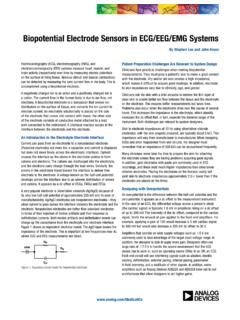Transcription of ANALOG TO DIGITAL CONVERTOR INTERFACE WITH 8051 ...
1 ANALOG TO DIGITAL CONVERTOR INTERFACE WITH 8051 MICROCONTROLLER DEBANAND MAJHI (109EE0278) BRAJESH ANAND (109EE0638) SAKSHAM MISHRA (109EE0639) Department of Electrical Engineering National Institute of Technology Rourkela - 2 - ANALOG TO DIGITAL CONVERTOR INTERFACE WITH 8051 MICROCONTROLLER A Thesis submitted in partial fulfillment of the requirements for the degree of Bachelor of Technology in Electrical Engineering By DEBANAND MAJHI (109EE0278) BRAJESH ANAND (109EE0638) SAKSHAM MISHRA (109EE0639) Under guidance of Prof. SUPRATIM GUPTA Department of Electrical Engineering National Institute of Technology Rourkela-769008 (ODISHA) May-2013 - 3 - DEPARTMENT OF ELECTRICAL ENGINEERING NATIONAL INSTITUTE OF TECHNOLOGY, ROURKELA ODISHA, INDIA-769008 CERTIFICATE This is to certify that the thesis entitled ANALOG to DIGITAL CONVERTOR INTERFACE with 8051 Microcontroller , submitted by Debanand Majhi (Roll.)
2 No. 109EE0278), Brajesh Anand (Roll. No. 109EE0638) and Saksham Mishra (Roll. No. 109EE0639) in partial fulfilment of the requirements for the award of Bachelor of Technology in Electrical Engineering during session 2012-2013 at National Institute of Technology, Rourkela. A bonafide record of research work carried out by them under my supervision and guidance. The candidates have fulfilled all the prescribed requirements. The Thesis which is based on candidates own work, have not submitted elsewhere for a degree/diploma. In my opinion, the thesis is of standard required for the award of a bachelor of technology degree in Electrical Engineering. Place: Rourkela Dept. of Electrical Engineering Prof. Supratim Gupta National institute of Technology Rourkela-769008i ACKNOWLEDGEMENTS We would like to articulate our deep gratitude to our project guide Prof.
3 SUPRATIM GUPTA who has always been source of motivation and firm support for carrying out the project. We would also like to convey our sincerest gratitude and indebtedness to all other faculty members and staff of Department of Electrical Engineering, NIT Rourkela, who showed their great efforts and guidance at required times without which it would have been very difficult to carry out our project work. Moreover , an assemblage of this nature could never have been attempted with our reference to the works of others whose details are mentioned in the references section at the last. We acknowledge our indebtedness to all of them. Furthermore, we would like to take the name of our parents and God who directly or indirectly encouraged and motivated us during this dissertation. ii ABSTRACT In this paper we shall study how a 8051 microcontroller is interfaced with an ANALOG to DIGITAL CONVERTOR (ADC).
4 An ADC is a real world device which converts real time continuous quantities into DIGITAL values that represent the amplitude of the quantity. An ADC converts input ANALOG signals by quantizing it. Higher the sampling rate used to discretize the values more will be the accuracy with which the output from ADC is obtained. ADCs may be used in DIGITAL Signal Processing, in commercial applications as well as in music industries to convert the data from ANALOG to DIGITAL in order to create the data that will be used in compact disks. Further the circuit has been simulated using PROTEUS Demo version. iii CONTENTS Abstract i Contents ii List of Figures v List of Tables viii CHAPTER 1 INTRODUCTION Motivation 1 Microcontroller Architecture 1 a) Features of 8051 2 b) Registers 2 c) Pin Description of 8051 3 ADC Architecture 5 CHAPTER 2 8051 MICROCONTROLLER WITH ADC Algorithm for programming ADC 8 Assembly program to INTERFACE ADC with 8051 8 iv CHAPTER 3 SIMULATION AND OUTPUT Output 14 Output Analysis 15 CHAPTER 4 CONCLUSION v LIST OF FIGURES Fig.
5 No Name of the Figure Page. No. 1 8051 Microcontroller Block Diagram 2 2 8051 Microcontroller 5 3 ADC 0808 6 4 Block Diagram for interfacing ADC with 8051 Microcontroller 8 5 Circuit Diagram for interfacing ADC with 8051 14 vi LIST OF TABLES Table. No. Name of the Table Page. No. 1 Features of 8051 2 2 Output 14 1 CHAPTER1 Introduction1 MOTIVATION: In embedded system, it is essential that microcontrollers take ANALOG input. Sensors and transducers used in industry are ANALOG in nature. We need to convert the ANALOG output from the sensors to DIGITAL so that the corresponding signal can be processed by the controller. These are generally used in control operation and instrumentation in industries. ADCs are used everywhere when we have to process, store or transmit an ANALOG signal in DIGITAL form.
6 ADCs are used in TV tuner cards and for DIGITAL data processing in microcontrollers in the form of on chip 8 bit, 10 bit ADCs. Commercial ADCs are also used as integrated circuits. Convertors with a resolution of 8 to 24 bits are used and its sample frequency is in order of some KHz, Mega and Giga sample ANALOG to DIGITAL convertors are also used. They may be required in DIGITAL video cameras. DIGITAL to ANALOG Convertors may also be required in applications such as CD players, data which will be stored in binary form may be converted into ANALOG form by the DIGITAL to ANALOG convertors[1]. Here ADC 0808 is used. It is a 8-channel multiplexer, 8-bit ANALOG to DIGITAL converter and microprocessor compatible control logic. MICROCONTROLLER ARCHITECTURE: The 8051 microcontroller is an 8-bit microcontroller introduced by Intel corporation.
7 This microcontroller has 128 bytes of Random Access Memory(RAM), 4K bytes of on-chip Ream Only Memory(ROM), two timers, one serial port and four port(each 8-bits wide) all on a single chip. The Central Processing Unit(CPU) can work only on 8-bit of data at a time. The 8051 has four I/O ports, each 8-bits wide[2]. 2 Fig 1: 8051 microcontroller block diagram[5] Features of 8051[3]: Feature Quantity ROM 4K bytes RAM 128 bytes Timer 2 I/O pins 32 Serial port 1 Interrupt sources 6 Table Features of 8051[3] Registers: Registers are used to store information temporarily. The vast majority of 8051 registers are 8-bit registers. With an 8 bit data type, any data larger than 8 bits must be broken into 8-bits chunks before it is processed. Commonly used registers of the 8051 are A(accumulator), B, R0, R1, R3, R4, R5, R6, R7, DPTR(data pointer), PC(program counter).
8 Some special purpose registers are: 3 Program Status Word(PSW) Stack Pointer(SP) Data Pointer(DPTR) Accumulator(ACC) B Register(B) Timer/Counter mode control(TMOD) Timer/Counter control(TCON) Serial Control(SCON) Power Control(PCON) Pin Description of 8051: 8051 microcontroller has 40 pins which perform functions such as input/output, read/write, address, data interrupts. Out of the 40 pins, 32 pins are for the four ports namely: P0, P1, P2, P3. VCC, GND, XTAL1, XTAL2, , , ALE and RST are the other 8 pins available on microcontroller chip. VCC (Pin 40) Voltage input is +5V, purpose of VCC is to supply voltage to microcontroller. GND(Pin 20) Ground is also provided in 8051. XTAL1 AND XTAL 2(Pins 18 and 19) An external clock is required to run 8051. Two capacitors of 33pF are connected in addition to a quartz crystal oscillator to XTAL1 and XTAL2. The crystal oscillator used in our circuit has been set at MHz.
9 RST(Pin 9) 4 It is normally low, when a high pulse is applied to this pin, microcontroller will terminate all activities and reset all register values. (Pin 31) It is an input pin and should be connected to VCC. It is known as External Access. (Pin 29) (Program Store Enable pin) is an output pin. ALE(Pin 30) It is an output pin and stands for Address Latch Enable. P0(Port 0)(Pins 32 to 39) Port 0 can be used for address as well as data. If ALE=1, P0 has address A0-A7 and if ALE=0, P0 provides data D0-D7. Port 0 needs pull-up resistors of value 10K-ohm to be connected externally because P0 has no inbuilt pull-up resistors like P1, P2 and P3. P1(Port1)(Pins 1 to 9) and P2(Port2)(Pins 21 to 28) They are used as input/output pins. P3(Port3)(Pins 10 to 17) It is used as input as well as output port. No pull-up resistors are required in P3.
10 Apart from input/output it also provides interrupts. 5 Fig 2: 8051 microcontroller[5] ADC ARCHITECTURE The ADC used in the interfacing is ADC 0808. It has 28 pins, and can handle upto 8 ANALOG signals using one chip. It has got an 8-bit data output. The 8 input channels are IN0-IN7, and Vref(+)=5V; Vref(-) has been grounded. In order to select the inputs IN0-IN7; A, B and C addresses are used[4]. RST (RXD) (TXD) (INT0) (INT1) (T0) (T1) (WR) (RD) XTAL2 XTAL1 GND (AD1) (AD0) Vcc (AD2) (AD3) (AD4) (AD5) PSEN ALE/PROG EA/VPP (AD7) (AD6) 8051 6 Fig 3: ADC0808[5] IN0 IN7 GND CLOCK Vcc D0 D7 EOC OE A B B ALE SC Vref(+) Vref(-) ADC0808 7 CHAPTER2 8051 MICROCONTROLLER WITH ADC 8 ADC receives ANALOG signal from the source.
